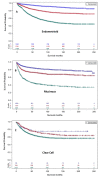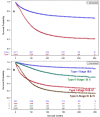Disease-Specific Survival of Type I and Type II Epithelial Ovarian Cancers-Stage Challenges Categorical Assignments of Indolence & Aggressiveness
- PMID: 31973035
- PMCID: PMC7168156
- DOI: 10.3390/diagnostics10020056
Disease-Specific Survival of Type I and Type II Epithelial Ovarian Cancers-Stage Challenges Categorical Assignments of Indolence & Aggressiveness
Abstract
Epithelial ovarian cancers (EOC) consist of several sub-types based on histology, clinical, molecular and epidemiological features that are termed "histo-types", which can be categorized into less aggressive Type I and more aggressive Type II malignancies. This investigation evaluated the disease-specific survival (DSS) of women with Type I and II EOC using histo-type, grade, and stage. A total of 200,658 EOC cases were identified in the National Cancer Institute's Surveillance, Epidemiology, and End Results (SEER) data. Kaplan-Meier survival analyses, one-factor ANOVA and Chi-square analyses were performed on 10-year DSS survivals. DSS strongly supported a 2-tiered classification (grade 1 vs. grade 2 & 3) for serous EOC. DSS of early stage serous EOC for grade 2 was significantly different from grade 3 indicating that a 2-tier classification for serous EOC applied only to late stage. DSS of Type I EOC was much better than Type II. However, DSS was 46-58% lower with late stage Type I than with early stage Type I indicating that Type I ovarian cancers should not be considered indolent. Early stage Type II EOC had much better DSS than late stage Type II stressing that stage has a large role in survival of both Type I and II EOC.
Keywords: Type I & Type II; epithelial ovarian cancer; grade; histo-types; stage; survival.
Conflict of interest statement
Page: 10The authors declare no conflict of interest.
Figures




References
-
- Howlader N., Noone A.M., Krapcho M., Garshell J., Miller D., Altekruse S.F., Kosary C.L., Yu M., Ruhl J., Tatalovich Z., et al. Seer Cancer Statistics Review. National Cancer Institute; Bethesda, MD, USA: 2015. [(accessed on 20 December 2019)]. pp. 1975–2016. Available online: https://seer.cancer.gov/csr/1975_2016/
LinkOut - more resources
Full Text Sources

